©
2004 Jeff Matthews & napoli.com
Galleria
Umberto
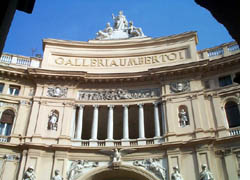 The first architectural results
of the industrial revolution sprang up in Britain in the middle of the
19th century: Joseph Paxton's Crystal Palace in 1851, for example, and
The Oxford Museum (1859) by Deane and Woodward. By using iron, these
architects sought to reconcile the split in the Victorian personality,
which viewed such industrial material as the substance of engines to
power modern society with, perhaps, but hardly the stuff of Architecture
with a capital A -- the discipline of designing museums, hotels, universities
and other such places for the genteel to gather. The first architectural results
of the industrial revolution sprang up in Britain in the middle of the
19th century: Joseph Paxton's Crystal Palace in 1851, for example, and
The Oxford Museum (1859) by Deane and Woodward. By using iron, these
architects sought to reconcile the split in the Victorian personality,
which viewed such industrial material as the substance of engines to
power modern society with, perhaps, but hardly the stuff of Architecture
with a capital A -- the discipline of designing museums, hotels, universities
and other such places for the genteel to gather.
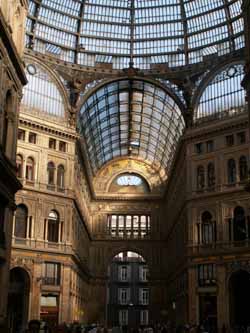 Such
use of glass and iron, however, was to revolutionize architecture and
eventually lead to the first steel-framed skyscrapers of the Chicago
architects before the century was out. High vaulted glass and iron domes,
governed by their own new architectural aesthetics, characterized a
number of structures built in Europe in the last decades of the nineteenth
century. The most prominent example in Naples is the Galleria Umberto
I (photo), across from San Carlo Theater.
It was inaugurated in 1890, and named for Umberto I, who was king of
Italy from 1878 until 1900 when he died at the hands of an assassin. Such
use of glass and iron, however, was to revolutionize architecture and
eventually lead to the first steel-framed skyscrapers of the Chicago
architects before the century was out. High vaulted glass and iron domes,
governed by their own new architectural aesthetics, characterized a
number of structures built in Europe in the last decades of the nineteenth
century. The most prominent example in Naples is the Galleria Umberto
I (photo), across from San Carlo Theater.
It was inaugurated in 1890, and named for Umberto I, who was king of
Italy from 1878 until 1900 when he died at the hands of an assassin.
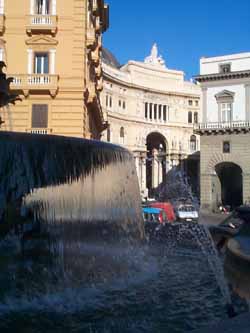 The
idea behind the Risanamento ('resanitizing')
of Naples in the 1880s and 90s was to clear large sections of the city
that for centuries had been nests of squalid overcrowding and disease;
then rational construction could take place. The wide boulevard known
as Corso Umberto (or the Rettifilo,
the 'straight line') running from Piazza della Borsa all
the way to the main train station at Piazza Garibaldi was one result
of this effort. The Galleria Umberto was another. The
idea behind the Risanamento ('resanitizing')
of Naples in the 1880s and 90s was to clear large sections of the city
that for centuries had been nests of squalid overcrowding and disease;
then rational construction could take place. The wide boulevard known
as Corso Umberto (or the Rettifilo,
the 'straight line') running from Piazza della Borsa all
the way to the main train station at Piazza Garibaldi was one result
of this effort. The Galleria Umberto was another.
There was
a need to renew the area across from San Carlo known as Santa Brigida,
and four designs were submitted. One by Emanuele Rocco was chosen. His
plan left in place a number of historic buildings that others would
have torn down, yet presented a high and spacious cross-shaped mall,
a truly cathedralesque affair surmounted by a great glass dome braced
by 16 metal ribs. Of the four glass-vaulted wings, one fronts on via
Toledo (via Roma), still the main downtown thoroughfare, and another
opens onto the San Carlo Theater, framed like a splendid proscenium
by the portals of the gallery. The Galleria Umberto was based
on the design of the gallery in Milan completed in 1865; yet, it was
a more aesthetic fusion of the industrial glass and metal of the upper
part and the masonry below, which, itself, is a spectacular collage
of Renaissance and Baroque ornamentation, tapering off to clean smoothness
of marble at the ground concourse.
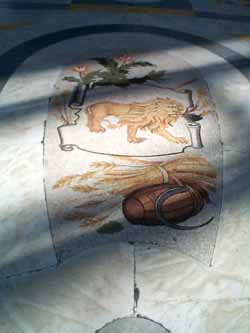 The
Gallery was built to stimulate commerce and to be a symbol of a city
reborn. It still contains numerous cafès, businesses, book and
record shops, and fashionable stores. Once it held theatres and restaurants
as well, and was, indeed, the sitting room of bourgeois Naples. Its
fate has come to be somewhat of a metaphor of Naples, meaning that there
are good times and bad, periods of splendour as well as decay. Among
its many ups and downs is even the fact that it was the target of aerial
bombardment by a dirigible in the First World War! The
Gallery was built to stimulate commerce and to be a symbol of a city
reborn. It still contains numerous cafès, businesses, book and
record shops, and fashionable stores. Once it held theatres and restaurants
as well, and was, indeed, the sitting room of bourgeois Naples. Its
fate has come to be somewhat of a metaphor of Naples, meaning that there
are good times and bad, periods of splendour as well as decay. Among
its many ups and downs is even the fact that it was the target of aerial
bombardment by a dirigible in the First World War!
These days,
you can still—and should still—marvel at the
architecture, its deceptive orderliness as it moves and shifts like
Proteus from one detail to the next. Yet, the Galleria also lets you
become for a moment the center of an equally fascinating bit of flesh-and-blood
architecture: a true human kaleidoscope swirls around you, on the way
to the opera, to work, to a rendezvous. Perhaps they are well-dressed,
perhaps dishevelled; the weird as well as the mundane, the casual and
the poised. From the perfectly nondescript to those who look like extras
in some bizarre film, they all have their own reasons for being drawn
to what is still a most remarkable structure.
d'Angri, Palazzo
 The Palazzo Doria d’Angri was finished in the late
1700s by Carlo Vanvitelli, who finished the work begun by his father,
Luigi Vanvitelli. Marcantonio Doria had
commissioned the building. The building faces out onto Largo dello
Spirito Santo and is bounded on either side by via Toledo
and via Monteoliveto. Decorative work was done by many of the
same artists who worked on the great Royal Palace in Caserta. The original
owners of the building, the Doria family, assembled a vast art collection,
including works by Caravaggio. These works, in addition to numerous
porcelain pieces, clocks, carpets, etc. have been lost over the years
through auction. The Palazzo Doria d’Angri was finished in the late
1700s by Carlo Vanvitelli, who finished the work begun by his father,
Luigi Vanvitelli. Marcantonio Doria had
commissioned the building. The building faces out onto Largo dello
Spirito Santo and is bounded on either side by via Toledo
and via Monteoliveto. Decorative work was done by many of the
same artists who worked on the great Royal Palace in Caserta. The original
owners of the building, the Doria family, assembled a vast art collection,
including works by Caravaggio. These works, in addition to numerous
porcelain pieces, clocks, carpets, etc. have been lost over the years
through auction.
In more
recent times, the building and the square in front, renamed Piazza
September 7, are well known because on that date in 1860, Giuseppe
Garibaldi, after his triumphant campaign from Sicily to Naples, stepped
out onto the balcony of the Palazzo d’Angri and proclaimed
the annexation of the Kingdom of Two Sicilies (The Kingdom of Naples)
to the Kingdom of Italy, thus ending a thousand years of separate history
of southern Italy and forming the modern nation of Italy. (See The Bourbons, part 3, for more about that period
in the history of Naples.)
Herman,
volcanoes (4)
[Photo
by Herman Chanowitz; restoration by
Tana A. Churan-Davis.]
 I can't
believe that Herman was holding out on me, or maybe I just didn't pay
sufficient attention when he told me of some "snapshots" he took during
WW2. I can't
believe that Herman was holding out on me, or maybe I just didn't pay
sufficient attention when he told me of some "snapshots" he took during
WW2.
Herman
is an American who has lived in Naples for many years with his Sicilian
wife. He was part of the WW2 invasion force in Salerno that fought its
way up the center of Italy, pushing the Germans back from Monte Cassino
and making its way up into Germany.
For his
efforts during the war and for all the time he has contributed as an
ambassador of good will in coordinating visits by young members of the
NATO community in Naples to various towns in the area that were directly
involved in wartime hostilities, Herman was recently made an honorary
citizen of the little town of San Pietro, not far from Cassino.
"Anyway,"
said Herman, "I have some snapshots I took in WW2."
"Oh." (Vague interest on my part.)
"I have a couple of Vesuvius."
"So do I, Herman."
"Are yours erupting?"
"As in the 1944 eruption?"
"Yup. Took'em from a Piper Club while we were flying over the eruption."
"You…were…flying…over…the…eruption…"
It took
Herman only 25 years to tell me that. It turns out that he has photos
from the North African theater all the way to the Nazi death camps.
I feel guilty about not wanting to see yet more photos of those horrors,
but I suppose I will have a look sooner or later. In the meantime, I
settled for a nice 8x10 glossy of the 1944 eruption of Mt. Vesuvius.
It has the classic dense column of smoke billowing thousands of feet
above the mountain. I am sure there are other photos like it, but this
one is mine.
Yiddish
(2), pizza (2)
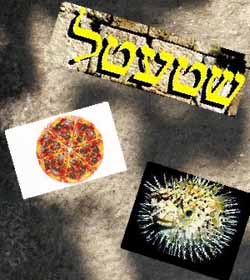 The
last few months have seen the growth of some good give–away morning
newspapers in Naples. One of them is City Napoli. It has three
pages of international news, a couple of pages of features and human
interest, a page or two on Naples news, a sports page and, of course,
a lot of advertising, which pays for the enterprise. The
last few months have seen the growth of some good give–away morning
newspapers in Naples. One of them is City Napoli. It has three
pages of international news, a couple of pages of features and human
interest, a page or two on Naples news, a sports page and, of course,
a lot of advertising, which pays for the enterprise.
This morning
there is a human interest story on the front page for a change. There
is a photo, taken in Portland, Oregon of a young man and woman—"street
people"— sitting on their bags on the sidewalk. One of them is
holding up a sign that says: "Pizza Schmizza paid me to hold this sign
instead of asking for money". The caption above the photo says: "The
Homeless. New frontiers in advertising". The paragraph below says, simply,
that the kids are paid only in pizza and soft-drinks, and that this
seems to be a new record in aggressive advertising. Reading between
the lines, they mean, I think, "a new low in advertising".
The reason
it was on the front page of a Neapolitan paper, no doubt, has to do
with the pizza. Neapolitans are always concerned that the rest of the
world is doing something wrong, clumsy, and unorthodox—with an
outright potential for true evil—with the real Neapolitan product.
My wife's comment upon eating a Taco Pizza in Honolulu pretty much sums
it up: "This is pretty good, but they should call it something else.
It's not pizza."
I ran into
a young Japanese cook in Naples a few weeks ago. He didn't speak a word
of Italian, but his sponsors in Kagoshima, Japan, had sent him to Naples
with an interpreter (!) to learn how to make real pizza and bring home
the bacon (not an authentic topping, by the way) to Japan where
he will strut his stuff in a genuine Neapolitan pizza place in Kagoshima.
That city and Naples have one of these strange "sister city" deals going.
There is also a street named "via Kagoshima" in Naples (see here). There may very well be young Neapolitan
cooks running around Kagoshima at this very moment with their interpreters,
learning how to make sushi and fugu, the infamous poisonous
puffer or blowfish of the family Tetraodontidae, class Osteichthyes,
and order Tetraodontiformes, the body of which contains a toxin
1250 times more powerful than cyanide, one serving of which costs $200,
and even a slightly imperfect preparation of which will kill you in
no time flat. There are no Japanese restaurants in Naples, and that
reassures me.
What the
paper didn't explain—and what the proprietor of my local morning
coffee bar wanted to know—was the name of the restaurant, "Pizza
Schmizza".
"Maybe
it's Neapolitan Yiddish," I said.
That didn't
do any good, since not even Neapolitan Jews speak or know anything about
Yiddish (see here).
"OK, then
it's a Yiddish example of what is called—depending on the context—
'echo-word reduplication,' 'linguistic doubling,' 'rhyming reduplication'
and, at linguistics department beer-parties, 'phonesthemic doubling'.
Some examples in English are drinky-winky, harum-scarum, helter-skelter,
higgledy-piggledy, and in so-called Cockney Rhyming Slang, 'loaf' for
'head' (since 'loaf of bread' rhymes with 'head'). Yiddish uses the
sound 'schm—' as the PSDA (Phonesthemic Secret Double Agent)
for humorous effect."
"Oh."
"So how about some coffee," I said.
"Coffee-schmoffee. How about you should pay me for yesterday morning
already."
Sant'Eligio
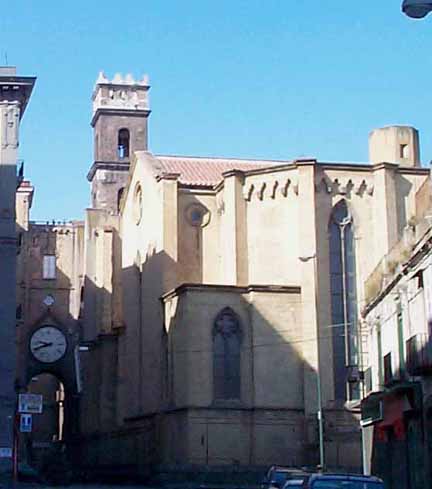 The French Gothic church of Sant’Eligio was built
during the reign of Charles of Anjou by the same congregation that built
the nearby Sant’Eligio hospital in 1270. It is the first church
built in Naples by the Angevin French. Little remains of the original
structure. The arched passageway that opens onto Piazza Mercato
(Market Square) is through the original façade of the church
and has since been incorporated into the structure of the ancient hospital. The French Gothic church of Sant’Eligio was built
during the reign of Charles of Anjou by the same congregation that built
the nearby Sant’Eligio hospital in 1270. It is the first church
built in Naples by the Angevin French. Little remains of the original
structure. The arched passageway that opens onto Piazza Mercato
(Market Square) is through the original façade of the church
and has since been incorporated into the structure of the ancient hospital.
Many of
the lines of the original structure came to light only in the course
of restoration after the bombardments of the WWII.
Much of the painted ornamentation adorning the church only goes back
to the great urban renewal of Naples in the last years of the 19th century.
Sant’Eligio and a number other Gothic structures in the area were
restored in this fashion.
It is interesting
to me how—in the long history of a city such as Naples—the
center of town shifts over the centuries. The Church of Sant'Eligio,
at one time, opened onto the most important part of the city, Piazza
Mercato (see here and here).
Here is where crowds gathered, where revolutions started, and where
public executions were held. It is, today, anonymous and totally ignored,
having been cut off from the rest of the city by the contructions of
the risanamento, the urban renewal
of Naples in the late 19th century. It is also adjacent to the entry
to the industrial port of Naples and, as such, was heavily bombed in
WW2. It is a mile removed from where the great cruise liners disgorge
tourists and money into the new center of town, Piazza Municipio.
Petty
theft (1)
 Getting
mugged is funny only in the movies. The best scene along those lines
in Italian cinema is probably from the 1988 film Fantozzi va in pensione
(Fantozzi Retires) with Paolo Villaggio. Villaggio (b. 1938) is a Genovese
actor/comic who has created the character of Ugo Fantozzi, a good-natured,
bumbling, and thoroughly mediocre bureaucrat who can do nothing right
and whom everyone takes advantage of. Villaggio brought Fantozzi to
life in a 1975 film; through the year 2000, ten films appeared. Some
critics have called the character the most original comic "mask" in
Italian cinema since Totò. Physically, Villaggio recalls
the American comic, Lou Costello, and the character of Fantozzi has
become a metaphor in modern Italy of the inept and put-upon Everyman
much in the same way as "Walter Mitty" or, more recently, "Dilbert,"
in the United States. Getting
mugged is funny only in the movies. The best scene along those lines
in Italian cinema is probably from the 1988 film Fantozzi va in pensione
(Fantozzi Retires) with Paolo Villaggio. Villaggio (b. 1938) is a Genovese
actor/comic who has created the character of Ugo Fantozzi, a good-natured,
bumbling, and thoroughly mediocre bureaucrat who can do nothing right
and whom everyone takes advantage of. Villaggio brought Fantozzi to
life in a 1975 film; through the year 2000, ten films appeared. Some
critics have called the character the most original comic "mask" in
Italian cinema since Totò. Physically, Villaggio recalls
the American comic, Lou Costello, and the character of Fantozzi has
become a metaphor in modern Italy of the inept and put-upon Everyman
much in the same way as "Walter Mitty" or, more recently, "Dilbert,"
in the United States.
In the
scene in question, Fantozzi is picking up his first pension check at
the post-office. Outside, of course, the hit-and-run petty thieves on
motorbikes are waiting, except that in this comic version they are all
waiting in an orderly line, each having taken one of those proper customer-service
numbers from a dispenser at the entrance to the thief staging area.
When Fantozzi gets his money and heads for the exit, the thief overseer
calls out to his charges, "OK, number 32 has left the window. Who has
32?" Two punks obediently raise their hands, and they are then
the ones who roar by and rip Fantozzi's pay envelope from his hand as
he leaves the post-office. If you don't find that funny, maybe you had
to be there—or maybe you have been mugged, yourself.
There was
certainly nothing funny about it in Naples the other day for Hari Ahuwalia,
a gentleman from India in town to sign a "sister city" pact between
his city of Calcutta and Naples. In 1992 Mr. Ahuwalia was on the first
Indian expedition to Mt. Everest. Also, he was wounded more recently
in an India/Pakistan border clash, as a result of which he is confined
to a wheel-chair. He was sitting outside of the Villa Pignatelli
on the Riviera di Chiaia, a popular tourist attraction in the
city these days. He was, perhaps foolishly, wearing a Rolex watch. He
was assaulted by two young thieves who took his watch and sped off.
The city was not pleased.
It is true
that he got his watch back, but not—as one paper reported—because
the thieves "repented". That lends an undeserved Robin Hood flavor to
the episode. What apparently happened was that bad "good guys"—very
tough plainclothes cops—went into the Spanish Quarter of Naples,
where they know many of these petty thieves hole up and threatened to
sit on the place forever. They can micro-harass an entire neighborhood
to death—confiscate motorbikes, ticket people for not wearing
safety helmets, for not having their "papers" in order, for littering,
for jaywalking, etc. The next day, the cops got the phone call they
were waiting for: the watch is in a bag at such-and-such a corner. The
retrieved it, and an agent flew to the Milan airport to return it to
Mr. Ahuwalia just as he was about to leave for home.
Filangieri
Museum
 Many things are not what they used to be, but the building housing
the Filangieri Civic Museum, on via Duomo, is not even where
it used to be! It was built between 1464 and 1490 by Tuscan artisans
at the behest of the wealthy Neapolitan merchant, Angelo Como, a favorite
at the Aragonese court. The building is, thus, in the style of the Florentine
Renaissance and is known as Palazzo Como. It was sold in 1587 and was
incorporated into an adjacent monastery. Many things are not what they used to be, but the building housing
the Filangieri Civic Museum, on via Duomo, is not even where
it used to be! It was built between 1464 and 1490 by Tuscan artisans
at the behest of the wealthy Neapolitan merchant, Angelo Como, a favorite
at the Aragonese court. The building is, thus, in the style of the Florentine
Renaissance and is known as Palazzo Como. It was sold in 1587 and was
incorporated into an adjacent monastery.
In 1881-82,
because of the demolition and construction going on during the
urban renewal of Naples (called, in Italian,
the ‘Risanamento’ —literally, ‘restoring to
health’), it was necessary to dismantle the entire building stone
by stone and move it back some 20 meters so that via Duomo could be
widened. Since that date, the building has housed the museum donated
by Gaetano Filangieri, prince of Satriano (not to be confused with his
homonymous grandfather—see here.)
Though
parts of the collection were destroyed in aerial bombardments in WW
II, the museum still displays an impressive assortment of arms, porcelain
and period costumes. Additionally, there is the recent addition of a
large table-top scale wooden model of the city of Naples as it existed
during the Spanish viceroyship.
At this
writing, the museum is closed for repairs as well as the construction
going on for the via Duomo station of the new Naples Metropolitana.
Many of the museums exhibits are temporarily on display in the Maschio Angioino.
Vergil
(2)
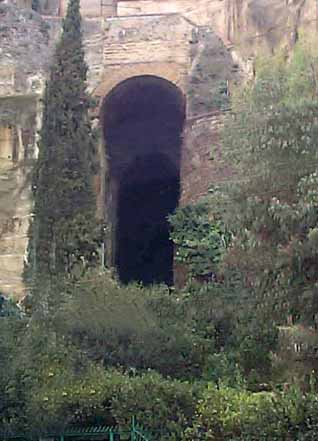 Across the street from the Mergellina train station is an
historical park known as The Tomb of Virgil,
the traditional last resting place of this immortal Roman poet, who
spent much of his life in the city of Naples. Legend says that
the poet—also renowned as a sorcerer—called
the tunnel into existence by his powers. (It may also have been Lucius
Cocceus Auctus, the great Roman engineer who built the nearby Seiano
Grotto and many of the fortifications of the Roman
Imperial Port in Baia.) Across the street from the Mergellina train station is an
historical park known as The Tomb of Virgil,
the traditional last resting place of this immortal Roman poet, who
spent much of his life in the city of Naples. Legend says that
the poet—also renowned as a sorcerer—called
the tunnel into existence by his powers. (It may also have been Lucius
Cocceus Auctus, the great Roman engineer who built the nearby Seiano
Grotto and many of the fortifications of the Roman
Imperial Port in Baia.)
Also, whether
or not the author of The Aeneid is actually buried here, another,
much more recent, poet is: the most famous of all Italian Romantics,
Giacomo Leopardi, who died in Naples in 1837. From within the park,
itself, you have a view of the entrance to a tunnel built by the Romans
in the second century B.C. to connect Naples and Pozzuoli.
This is
the tunnel, or ‘grotta,’ referred to in the name of this
area of the city, Piedigrotta—"at
the foot of the grotto". This tunnel was used on and off until well
into the 19th century before being superseded by the two modern tunnels
used by the traffic of today.
Archaeology (3)—
Uncovering
the "Little Venice" near Poggiomarino
 Naples
and the adjacent area near Mt. Vesuvius are always the stage for conflict
between antiquity and progress. Which do we need more, new metro stations
so people can move around the city more easily, or those original Greek
walls of the city now buried down there where those shiny new trains
would like to run? You get various answers depending on whom you
ask and how you phrase the question. I remember when they restored the
grimy and weathered stone of the Aragonese Victory Arch over the entrance
to the Angevin Fortress some years ago. The arch looked good when they
finished it, and it managed to keep its new complexion, oh, for a number
of days until it was defaced by eggshell grenades maliciously filled
with red ink. The missiles were tossed not by random vandals, but by
those making a political statement that the city spends too much on
the past and not enough on the present. Naples
and the adjacent area near Mt. Vesuvius are always the stage for conflict
between antiquity and progress. Which do we need more, new metro stations
so people can move around the city more easily, or those original Greek
walls of the city now buried down there where those shiny new trains
would like to run? You get various answers depending on whom you
ask and how you phrase the question. I remember when they restored the
grimy and weathered stone of the Aragonese Victory Arch over the entrance
to the Angevin Fortress some years ago. The arch looked good when they
finished it, and it managed to keep its new complexion, oh, for a number
of days until it was defaced by eggshell grenades maliciously filled
with red ink. The missiles were tossed not by random vandals, but by
those making a political statement that the city spends too much on
the past and not enough on the present.
A similar
conflict is being played out in the town of Poggiomarino, on the Sarno
river, not far from Pompei. The Sarno river is, one reads, the most
polluted river in Europe. That is staggering. What the area needs—besides
a powerful environmental patron demon who kills polluters right on the
spot—is a water purification facility placed at a strategic point
far enough inland so that the populace between that point and Torre
Annunziata on the coast no longer have to live on the banks of a
toilet and such that the water that reaches the Mediterranean Sea is
clean. Poggiomarino was to be the site for such a facility.
Then, in
October 2000, a significant archaeological discovery was made while
construction of the new purification plant, itself, was underway. The
site is already being called "little Venice" by archaeologists (in the
same way, I suppose, as they refer to the prehistoric village in Nola
as a "Bronze Age Pompeii" [see here]—maybe
it helps drum up support). To wit: a 20–acre Bronze Age settlement,
inhabited between 1700 and 700 b.c. Ancient engineers ingeniously drained
a large swamp to their advantage, creating raised artificial islands
of wooden pilings for their homes and using the waters of the Sarno
river to feed a system of canals—which is where the "little Venice"
part comes in. Hundreds of thousands of ceramic shards have been found,
as well as hundreds of items of wood, bronze, glass, amber, iron, and
wrought bone and animal horn.
Such
"pile-dwellings" are more commonly associated with the remains of primeval
villages in the Alps and pre-alpine regions. This one in Poggiomarino
is the only example, thus far discovered, of such a settlement in southern
Italy. Speculation is rampant: Who were they? Why did they leave? Were
they pushed out by the early encroachers of Magna
Grecia? Are these the people who moved a short distance away and
built the settlement that would grow into Roman Pompeii some centuries
later? The site is so significant that there is already talk of a Prehistory
Park in the area. That is very ambitious. In any event, work on the
water purification facility has stopped. It will have to be built elsewhere—but
it certainly has to be built.
Bruni,
Sergio
 It
has been a bad year for the Neapolitan Song. In March, Roberto Murolo passed away, and the day before yesterday
it was the turn of Sergio Bruni. He was 82. Services will be held today
in the "artists' church," the Church of San
Ferdinando, across from the Royal Palace. It
has been a bad year for the Neapolitan Song. In March, Roberto Murolo passed away, and the day before yesterday
it was the turn of Sergio Bruni. He was 82. Services will be held today
in the "artists' church," the Church of San
Ferdinando, across from the Royal Palace.
Bruni was
praised in the pages of il Mattino, the Neapolitan daily, by
Roberto De Simone, musicologist and
the authority on anything musical having do with Naples, from opera
to folk and pop music to—in this case—the Neapolitan
Song. De Simone recalls that playwright Eduardo
de Filippo once called Bruni "the voice of Naples," a title that
stuck, as did De Simone's own reference to Bruni as an "aristocrat from
the people". Bruni, in fact, was born poor in Villaricca, a town near
Naples, and started his life in music by learning to play the clarinet
for the town band. Sergio Bruni was a stage name; his real name was
Guglielmo Chianese.
Though
perhaps not the academic anthologist of music that Murolo was, his active
career as a singer spanned more than three decades, starting in the
1950s, and—with Murolo— Bruni enjoyed the reputation of
one of those performers who helped the Neapolitan Song survive the onslaught
of American popular music at mid-century. He was a dedicated opponent
of the napolesi, as he called them (using a non-word instead
of the standard adjective, napoletani to describe the false
quality that he detested), those purveyors of commercial "Neapolitan-ness,"
the hawkers of 'o sole mio. When, some years ago, the Italian
state television network, RAI, pulled the plug on its Festival of Neapolitan
Song, Bruni said that he and his friends popped open four bottles of
champagne to celebrate. And when he read a music maven's complaint in
1975 that the "true" Neapolitan song was dead, he teamed up with noted
Neapolitan poet Salvatore Palomba to write the haunting Carmela,
now a classic and one of the best-loved of all Neapolitan
songs.
In the
1970s he again worked with Palomba in a television production entitled
"Unmask Pulcinella," noted—as the title might imply—for
its lack of sentimentality about Naples, the "land of sun", yes, but
also the land that hundreds of thousands of emigrants had deserted earlier
in the century in order to find a better life. In such work, it is fair
to regard Bruni as a forerunner of more recent singer/songwriters such
as Pino Daniele and others, whose music is often a litany of what has
gone wrong with Naples.
Bruni was
both a Communist and a devout Roman Catholic, one, they say, who would
read the Bible before dinner and Che Guevarra at bedtime. He was an
active participant in the popular uprising against German troops in
the city in 1944, an episode known as "The
Four Days of Naples". His other activities included, for example,
a brief appearance as a hotel musician in Billy Wilder's delightful
1972 film, Avanti .
Serra
di Cassano, Palazzo
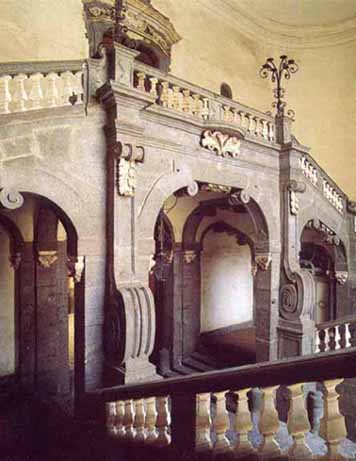 The Palazzo Serra di Cassano is up from and behind
Piazza Plebiscito on via Monte di Dio, the road leading
up to the height of Pizzofalcone. It is from the first half of the 1700s
and to this day represents the finest in the tradition of Neapolitan
urban architecture. It was built by Ferdinando Sanfelice, also responsible
for the construction of the nearby Nunziatella,
the military academy in the days of the Bourbons. The Palazzo Serra di Cassano is up from and behind
Piazza Plebiscito on via Monte di Dio, the road leading
up to the height of Pizzofalcone. It is from the first half of the 1700s
and to this day represents the finest in the tradition of Neapolitan
urban architecture. It was built by Ferdinando Sanfelice, also responsible
for the construction of the nearby Nunziatella,
the military academy in the days of the Bourbons.
The building
is vast, originally having entrances on two different streets; the one
that used to open onto via Egiziaca facing the Royal Palace was
closed many years ago, however, in 1799 when the owner closed it to
protest the execution of his son, said to be involved in revolutionary
activities of the day. He said the door would remain closed until the
ideals for which his son died were realized. It is still closed. The
dual portals of the entrance on via Monte di Dio open onto
twin curved stairways (photo) leading up over an octagonal courtyard.
The elegance of the decoration, chandeliers, inlaid marble, etc. make
the Palazzo Serra di Cassano a paragon of regal Bourbon residences.
Today it houses the Italian Institute for Philosophical Studies.
Pazzariello;
Marotta, G. (3)
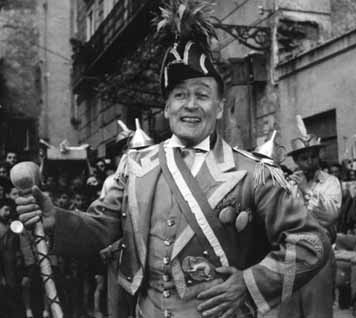 I have heard that the pazzariello still exists,
but I have never seen one except in a period re-enactment of the Naples
of days gone by. Indeed, in April 1997, RAI, the Italian state radio,
ran a short program called "The Last Pazzariello of Naples" in which
they went to a hospital in the Spanish Quarter and talked to Michele
Lauri, born in 1920, the gentleman purported to be the last of his kind
except, as I say, in re-enactments. (Also see
here.) "Don Michele" said he had plied his trade from the end of
WWII until the late 1980s—50 years of being a pazzariello,
then, eventually, the last one in Naples. For many centuries, before
mass printing and then electronics made it so much easier to spread
the word, there was a profession called "town crier" or some variation
thereof—a person paid to walk around and shout out the news of
the day and also get in a few ads for local merchants. The pazzariello
was that person in Naples. I have heard that the pazzariello still exists,
but I have never seen one except in a period re-enactment of the Naples
of days gone by. Indeed, in April 1997, RAI, the Italian state radio,
ran a short program called "The Last Pazzariello of Naples" in which
they went to a hospital in the Spanish Quarter and talked to Michele
Lauri, born in 1920, the gentleman purported to be the last of his kind
except, as I say, in re-enactments. (Also see
here.) "Don Michele" said he had plied his trade from the end of
WWII until the late 1980s—50 years of being a pazzariello,
then, eventually, the last one in Naples. For many centuries, before
mass printing and then electronics made it so much easier to spread
the word, there was a profession called "town crier" or some variation
thereof—a person paid to walk around and shout out the news of
the day and also get in a few ads for local merchants. The pazzariello
was that person in Naples.
Typically,
he dressed in mock military garb—a homemade uniform with bizarre
medals, epaulets and a diagonal sash across the chest. He wore a fancy
French Bourbon tricorn hat, usually with the points at front and back
instead of on the side and carried a large baton. He looked perhaps
more like a circus ringmaster than a general, but at least it was conspicuous.
The pazzariello (from the Neapolitan verb pazziare—to
joke) was usually accompanied by a small band of at least a flautist
and a bass-drum. He paraded around the streets and announced that a
new shop was opening, or that this or that shop was almost giving away
merchandise, so hurry, hurry, hurry—or that so-and-so had lost
a wedding ring and would the finder please have it in his heart to return
it. He told a few jokes, rhymed a few couplets, and there were also
the obligatory bits of gossip and anti-establishment comments. He and
his small entourage picked up the few coins that people tossed their
way.
If the
pazzariello is familiar at all to those outside of Italy, it
is probably through the 1954 film, L'oro di Napoli (The Gold
of Naples), directed by Vittorio De Sica (1901-74). The film consists
of five episodes (six in the US release) based on those found in the
1947 book of the same name by Giuseppe Marotta (1902-1963). The first
episode in the film (il guappo—the Racketeer) revolves
around the character of a pazzariello, played by the great Totò
(See photo, above). (Don Michele, the real deal, had a bit part in the
film and was a technical advisor.) Totò's performance is uncharacteristically
dark and melancholy and the episode has been called by one critic the
last bit of true "neorealism" to come from De Sica (the director of
The Bicycle Thief and Umberto D) before he started making
more light-hearted fare.
[Click
here for an item about another story in the book, The Gold of
Naples, an episode that was not in the film. Also
here for an episode from both book and film.]
Capri
(1)
| Capri,
looking down down from Monte Solaro to the Villa Tiberius and, in
the background, the tip of the Sorrentine Peninsula. |
 Capri
first attracted real and royal attention when Caesar Augustus
dropped by in 29 B.C. He liked it so much that he traded Ischia for
it. Since that time, there has been an unbroken chain of Capri admirers,
from the Longobards to the Normans,
Angevins, Spanish, Austrians, English
and modern Italians. All this attention is understandable. Of the islands
in the Bay of Naples, Capri simply has the most to offer. It is geologically
spectacular, from its two high points, Monte Solaro and Monte
Tiberius, rising like pillars at opposite ends of the island, to
natural wonders such as the Blue Grotto and the twin rocks known as
the faraglioni jutting up from the waters just off the east end
of the island. Capri
first attracted real and royal attention when Caesar Augustus
dropped by in 29 B.C. He liked it so much that he traded Ischia for
it. Since that time, there has been an unbroken chain of Capri admirers,
from the Longobards to the Normans,
Angevins, Spanish, Austrians, English
and modern Italians. All this attention is understandable. Of the islands
in the Bay of Naples, Capri simply has the most to offer. It is geologically
spectacular, from its two high points, Monte Solaro and Monte
Tiberius, rising like pillars at opposite ends of the island, to
natural wonders such as the Blue Grotto and the twin rocks known as
the faraglioni jutting up from the waters just off the east end
of the island.
 Nowhere
in the Gulf of Naples or vicinity, not from any of the other islands,
not even from the mountains above nearby Sorrento, will you find a view
equal to that from the vantage points on Capri. (The photo shows the
view across the straits to the tip of the Sorrentine peninsula.) Its
manmade attractions are also hard to beat: an old Saracen
tower on Mt. Barbarossa, the cliffside path named via Krupp,
a hermitage, a monastery, and the most serene chairlift you will find
anywhere, leading from the town of Anacapri up to the top of Monte Solaro. Additionally,
you can hike, hang-glide, scuba-dive, go down in a submarine, shop till
you drop, and then relax with all the other "beautiful people" at an
open-air cafe in one of the most famous squares of its kind in the world.
So, even if, unlike Tiberius, you never get to "relax with equal application
into secret indulgences and immoral pastimes," you can still rely on
having a good time if you follow some simple rules. Nowhere
in the Gulf of Naples or vicinity, not from any of the other islands,
not even from the mountains above nearby Sorrento, will you find a view
equal to that from the vantage points on Capri. (The photo shows the
view across the straits to the tip of the Sorrentine peninsula.) Its
manmade attractions are also hard to beat: an old Saracen
tower on Mt. Barbarossa, the cliffside path named via Krupp,
a hermitage, a monastery, and the most serene chairlift you will find
anywhere, leading from the town of Anacapri up to the top of Monte Solaro. Additionally,
you can hike, hang-glide, scuba-dive, go down in a submarine, shop till
you drop, and then relax with all the other "beautiful people" at an
open-air cafe in one of the most famous squares of its kind in the world.
So, even if, unlike Tiberius, you never get to "relax with equal application
into secret indulgences and immoral pastimes," you can still rely on
having a good time if you follow some simple rules.
First,
pronounce it CAH-pri, not cuh-PRI. This is essential to the enjoyment
of your stay, since this common tourist mispronunciation of the name
of the island sounds just like a local dialect expression meaning, "Please,
I would like to give you some more of my money."
Next,
if you have the time—and if you haven't, maybe you shouldn't
go—enjoy a ferry trip from the main port downtown, at least one-way.
Hydrofoils are great, but so are open-air sea trips. In the warm summer
months, you can also take a marvelous detour by ferry over to Sorrento
and then back to Naples. If you have a choice, go on a week-day, not
a week-end, although in the peak season, there may not be much difference.
Fortunately, since the island is virtually a web of footpaths, you will
be free to take advantage of the fact that most tourists don't really
like to walk. You can find solitude on Capri, even in the high season.
Prepare
an itinerary that says:
(a)
Blue Grotto
(b)
The Villa of Tiberius
(c)
The Villa of Axel Munthe
(d)
Monte Solaro
(e)
Afternoon free for shopping
Then take
a small hammer, which you should always keep with you for such occasions,
and rap yourself soundly in the skull to cure yourself of the notion
that it is possible to do it all in one day. Relax.
 Divide
the island, for touring purposes, into two parts, and then decide on
one or the other for your visit. The two parts are Capri and Anacapri.
Capri includes the delightful little main square in the town of Capri,
itself, and everything leading out towards the eastern height of the
island and the villa of Tiberius. It might also include going down the
via Krupp pathway to the north side of the island and the Marina
Piccola (small harbor). Divide
the island, for touring purposes, into two parts, and then decide on
one or the other for your visit. The two parts are Capri and Anacapri.
Capri includes the delightful little main square in the town of Capri,
itself, and everything leading out towards the eastern height of the
island and the villa of Tiberius. It might also include going down the
via Krupp pathway to the north side of the island and the Marina
Piccola (small harbor).
The Anacapri
side of the tour includes the town of Anacapri, itself (quaint and less
frequented than its famous sister town) and Monte Solaro, accessible
on foot or by chair lift. If you feeling particularly energetic, you
can walk from the main port to Anacapri up the so-called "Phoenician
stairs" (that zig-zag line in the center of the photo, right.) You might
add a third part to your trip: the sea. Take a trip into the Blue Grotto,
or take a trip around the entire island. Also, undersea sightseeing
is available via a small submarine!
No private
vehicles may be taken over to Capri, but there are taxis and buses available
from the port to virtually every part of the island accessible by wheel.
Capri, however, is truly made for walking. When you disembark, avoid
the temptation to follow the crowd over to the cable car that takes
you right up to the main square in the center of the town of Capri.
Take the steps; they start a little bit past the cable-car entrance.
They are moderately strenuous, but provide a first-class view of the
picturesque houses, small gardens and paths that abound on Capri. If
you plan to go to Tiberius' Villa Jovis, the only way is to walk from
the main square, so you may wish to save yourself for that. At the Anacapri
end, treat yourself to the chairlift up and then hike down, taking in
the view and the mountain air.
Frequent
ferry and hydrofoil service is available to Capri from Naples,
from both the main port and the nearby harbor of Mergellina. Additionally,
you can get to Capri from Sorrento. If you are truly crazy, you can
get a helicopter from Capodicchino airport in Naples.
Musical
instruments
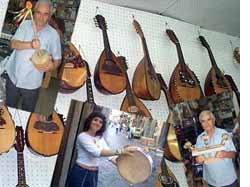 Two musical instruments closely associated with Naples
are the typical Christmas instruments, the zampogna
(bagpipe) and the ciaramella (folk oboe). Two musical instruments closely associated with Naples
are the typical Christmas instruments, the zampogna
(bagpipe) and the ciaramella (folk oboe).
Additionally,
there is, of course, the Neapolitan mandolin, a selection of which you
see in the photo on the left. The 18th-century Neapolitan mandolin
is characterized by a pear-shaped resonating chamber, an open
soundhole, and an angled top where the tuning pegs are located. The
most typical feature is the set-up of the strings: four pairs of double
strings, each pair tuned to the same note, allowing for the typical
mandolin sound, the tremolo, when struck by the plectrum. The strings
are generally tuned to g-d-a-e.
The instrument
developed in Naples in the 18th century and by now has a long history
in popular as well as classical music, including a prominent role in
Mozart's Don Giovanni (1787). The introduction of steel strings
in the mid–19th century in Naples gave the instrument a more piercing
sound particularly suited to the virtually non-existent acoustics of
outdoor performances of popular songs.
Among the
percussion instruments widely used in folk and popular music in Naples
is the so-called caccavella (upper-left in photo collage,
above). This term can often be used in a non-musical context to
mean "broken down old wreck"—for example, as applied to a car;
the instrument is also known as the putipu, onomatopoeia for
the "burping" sound the instrument makes when played. The instrument
consists of a membrane stretched across a resonating chamber, like a
drum. Instead of the membrane being stuck, however, a handle is used
to compress air rhythmically within the chamber; the air then spurts
out of the not-quite-hermetic seal that fastens the membrane to the
wooden body of the instrument. The sound is reminiscent of the sound
you get when you cup the palm of your hand into your armpit and snap
the upper arm down—(not that you would ever do such a thing).
Another
percussion instrument is the triccaballacca—a clapper—(bottom
right in photo). It has three percussive mallets mounted on a base,
the outer two of which are hinged at the base and are moved in to strike
the central piece; the rhythmic sound is produced by the clicking of
wood on wood and the simultaneous sound of the small metal disks—called
"jingles"— mounted on the instrument.
Typical
of Neapolitan folk music —and much folk music throughout Europe—is
the hand drum known as the tambourine or, in Neapolitan, tammorra.
It consists of a circular frame with a single drum head stretched
across one side of the instrument. There are generally small metal "jingles",
as with the triccaballacca, mounted around the perimeter of the
instrument, that sound as the tammorra is struck by the knuckles
or the open hand.
[These
photos were taken in the music shop of Giuseppe Miletti (the gentleman
in two of the photos) at Via S. Sebastiano 46.]
Galleria
Principe di Napoli
 The Gallery Principe di Napoli, across the street from
the National Archaeological Museum, is
the galleria that nobody thinks of when you say "galleria"
in Naples, that honor being reserved for the grander Galleria
Umberto I. The Gallery Principe di Napoli, across the street from
the National Archaeological Museum, is
the galleria that nobody thinks of when you say "galleria"
in Naples, that honor being reserved for the grander Galleria
Umberto I.
The Principe
di Napoli was started in 1870 and finished in 1883. Architecturally,
it was part of the wave of urban renewal
made possible throughout Europe by the new technology of steel and glass
construction epitomized by such buildings as the Crystal Palace
in London in 1851. With its Parisian passages and Londonesque arcades
the Gallery was built to be a shopping center, or—in more modern
terms a mall.
The gallery
is slightly out of kilter because the adjacent large and untouchable
Church of Santa Maria di Costantinopoli made the construction of a logical
fourth wing impossible. There are, thus, only three entrances: from
the side of the National Museum, the Salita del Museo and the Art Academy
(the point from which this photo was taken). The Gallery was, therefore,
considered to be somewhat of an architectural flop. Neither did it enjoy
the commercial success expected. It remains, however, important as an
architectural precedent in the city, being, of course, later
overshadowed by the Galleria Umberto, built over a decade later.
Today, the Principe di Napoli houses government and private offices.
|
